Refreshing the Ludwigia palustris mini ‘Super Red’
“Stem plants” are those that have leaves coming off a central stem and contrast with rosette plants with leaves sprouting from a central locus. Stem plants grow fast, and can get big so require some maintenance. The easiest method is to simply cut off and discard the tops of the plants to keep them down to size. Often you’ll get two new stems emerging from below the cut site which can increase the bushiness of the plant as well. That being said, sometimes you don’t want more bushiness, and sometimes things just need a proper do-over.
I planted Ludwigia palustris mini ‘Super Red’ six months ago and it’s been a fantastic plant. Allegedly able to grow to 30 cm, this fast growing ‘mini’ stem plant in the Fireplace Aquarium comfortably gets to 50 cm and grows about 5 mm per day once it gets going. At that rate it doesn’t take long before the plant is too big for the tank so I’ve been periodically cutting off and removing the tops. The plants get great looking new growth from where they’ve been trimmed, but the leaves at the bottom of the plant eventually get ratty and covered with algae. I’m going to fix that by giving these plants a reset – removing the whole plant and replanting only the nice looking tops of the plants.
The Ludwigia have a straightforward root system that comes out entirely and easily if gently pulled straight up. A little shake removes any aquasoil trapped in the roots. This is not a very messy process and there is no need to remove any of the fish. Nevertheless, it’s best to do the messy parts when the tank is full of water before a regular water change so any debris released in the process can be removed. I do weekly 50% water changes – around 20 litres – but this time I did a larger water change of maybe 35 litres. This let me vacuum up most of the debris and give the aquasoil a good cleaning, give the walls of tank a quick algae-scrape with a credit card blank, and also let me treat the inside of the bubble tube with “liquid carbon” algaecide to mitigate the green algae that had been building up in the lower reaches.
Prepare the plant tops for replanting
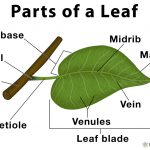
There’s no need to replant everything, so going back in with only the choicest looking tops is fine. I aim to get stems planted to a depth of around 4 cm so the lowest leaves that are going to be under the surface need to be removed to make sure they don’t rot. My secret is to take off the leaf blade but to leave on the petiole, the thin stalk of the leaf that connects it to the stem of the plant. When the leaf stem is pushed down into the substrate, the petioles will naturally fold up against the stem but if the stem tries to work its way back out of the soil the petioles will act as barbs to keep the stem in place. If there are adventitious roots on the stem, leave those on – they will give the new root system a great head start getting developed.
Pinsettes make replanting easy
Right tool for the job! I use straight, short ADA pinsettes for replanting. These are a precision instrument with very narrow tips, great grip and the right amount of springiness that makes them easy to use. Because they are narrower than traditional aquarium tweezers, they don’t leave behind a big channel when pulled out which means planted stems stay in place.
Grip the base of the stem firmly with the pinsettes aligned straight along the length of the stem. Avoid gripping the petioles. If the stem you are planting is long enough, you can easily support the leafy top in your hand while gripping the bottom with the pinsettes. Firmly plunge the pinsettes holding the stem to be planted down into the substrate and try to get the full length of the bare stem down to a good depth – don’t be afraid to dig around a little with the pinsettes to get the full depth you need. Then gently release your grip on the pinsettes while withdrawing the pinsettes straight up. The stem will remain in the substrate, anchored by the petioles. You can tap around on the surface of the substrate to make sure it forms up around the planted stems.
Replanted tops grow really well
Fill in the area you want to plant and be sure to check visually from more than one angle as refraction through the walls of the aquarium can make distances look deceiving. It shouldn’t take long to see more new growth from the plant tops.

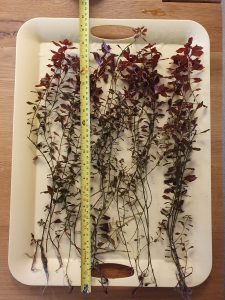
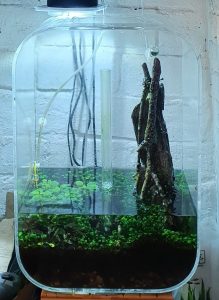
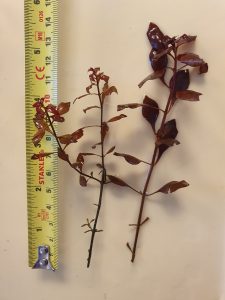
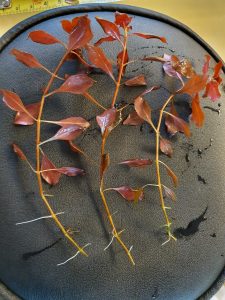
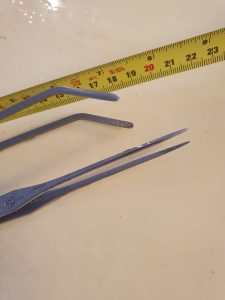

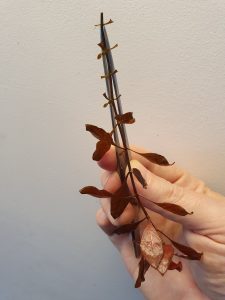
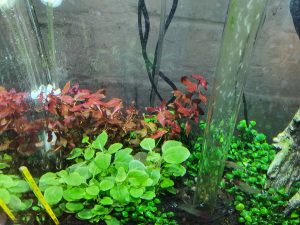

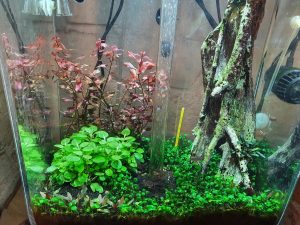
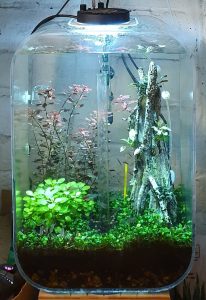
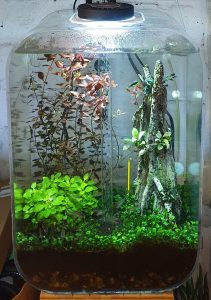
Sagi says:
Hi, the Ludwigia off cuttings are very long themselves, can these trimmed stalks
be trimmed again themselves before replanting?
Thus multiple the planting
Andy Pierce says:
Yes, you can cut the top piece to be replanted down as short as you’d like. I have never tried replanting the middle section from a cut stem that does not include the natural top, but expect this will work, particularly if you include some branching off points.
Canton Aquatics says:
This was a fantastic read! Your detailed approach to maintaining Ludwigia palustris mini ‘Super Red’ is super helpful, especially the insights on resetting stem plants to keep them looking their best. I appreciate the tip about timing the replanting with a water change to manage debris—such a smart move! Looking forward to updates on how the plants settle in!